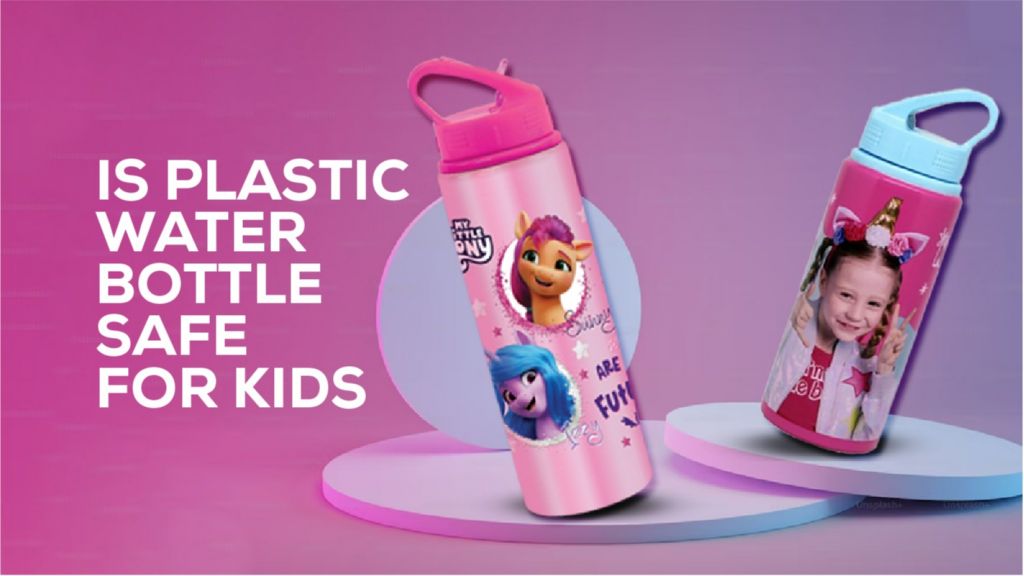Plastic water bottles can
commonly be safe for children to apply. However, there are some things to bear
in mind:
1. Choose BPA-free bottles: Look for bottles
that are categorized as BPA-free. BPA (Bisphenol A) is a chemical commonly
used in the manufacturing of plastic bottles and packing containers. While the
health effects of BPA are nevertheless being studied, it is generally advocated
to avoid BPA publicity, especially for babies and young youngsters.
2. Check bottle fine: Ensure that the plastic
bottle is of suitable quality and loose from any cracks, leaks, or damages.
Damaged bottles may additionally leach harmful chemicals into the water.
3. Use bottles categorized as meals-grade:
Look for bottles that might be mainly categorized as meals-grade or
appropriate for storing drinks. These bottles are designed to meet safety
requirements for food and drinks garage.
4. Clean bottles frequently:
Regularly clean the bottles the use of warm soapy water and rinse them very
well. Bacteria can develop in moist environments, so it is crucial to keep the
bottles clean.
5. Avoid hot liquids: Do no longer use plastic
bottles to save hot drinks, as excessive temperatures can motive chemical
substances from the plastic to leach into the liquid. Alternatively, you could
keep in mind using chrome steel or glass water bottles as more secure
alternatives to plastic. These substances do now not include harmful chemical substances
and are typically considered safe for youngsters. As a figure, are you constantly
concerned approximately the health of your infant? If yes, then why do you let
your child drink from a plastic water bottle every day? We all recognize
thoroughly that plastic isn't simply deteriorating our surroundings but is also
hazardous to our health. Plastic can undeniably be the worst side impact of our
contemporary lifestyle and generation. Plastic water bottles are one of the
most important sources of pollution responsible for land and water
pollutants. And no longer best this, the water saved in these plastic water
bottles is toxic in nature as harmful chemicals from the bottle leach into the
water over the span of time.
Harmful effects of plastic water
bottles There are a number of invisible unwell-consequences of the usage of
plastic water bottles, the consequences of which could most effectively be seen
in the lengthy run. Some of those unwell results are mentioned under: BPA
or Biphenyl A is a chemical which is commonly determined in plastic water
bottles.
It mimics estrogen and might
interfere with the hormonal cycle of the frame. It may also purpose
complications in watching for mothers and affect the health of the fetus. It
can also result in weight problems, diabetes, fertility troubles, and early
puberty. When exposed to direct solar or warmth, plastic bottles produce
dioxin, which could increase the possibility of breast cancer. Water
stored in plastic water bottles regularly consists of arsenic, fluoride, and aluminum,
which makes it just as horrific as a sluggish poison.
Single-use, disposable plastic
bottles may additionally motive chemical contamination and toxicity to the
ingesting water. Exposure to daylight and warmth can cause the release of
poisonous chemical substances from the plastic into the water. That approach
leaving water bottles in open areas should heat them, as the water may be hazardous
for ingesting. Many researchers observed microplastic contamination while bottles
were left in hot weather for the long term. There is a threat the water contains
traces of dangerous chemical substances, pesticides, and different impurities
that can be poisonous to your fitness. After the ban on bisphenol-A or BPA
being utilized in packaging, bottled water companies commenced the subsequent
method to get rid of BPA in their merchandise. But there’s nonetheless a threat
of dangerous chemical substances in plastic water bottles. Among those
components have been endocrine disrupting chemicals (EDCs), like BPA,
which can be man-made compounds
that intrude with hormone signaling and might adversely affect human fitness
as they're implicated in cancer, cardiovascular, and metabolic problems. In the
take a look at they observed what is called Steroid Receptor agonists and
antagonists. Out of 18 one of a kind brands of Bottled Water they located
these chemicals in 13 of the
samples, wherein they blocked steroid receptors with the aid of ninety%. The
most hormonally energetic belonged to instructions of chemicals referred to as
"maleates” and "fumarates”, which can be used to fabricate the shape of
plastic resins used in water
bottles. One other take a look at discovered that chemicals like BPA, benzene,
microbes, and in a few cases, arsenic were found in bottled water and which
adversely affected human fitness.
Water infection consequences from
exposure to toxins and chemicals that result in severe health troubles. Even
hint quantities of chemical substances can impact the body and generate a
number of signs. There is proof of higher levels of microplastics in bottled
water, even in popular brands. Scientists additionally discovered that the infection is at the least
partially coming from the packaging and/or the bottling system itself as the
principle plastic particles determined are polyester (primary polyethylene terephthalate
PET) which is used the make the bottle frame and polypropylene (PP) that's used
to make the plastic bottle caps. This query is tough to reply because there are
numerous types of plastics used and there are disagreements over the claims
made approximately them in my view. Polycarbonate stands out as the only
worried inside the most controversy due to its claimed residues of bisphenol A
(BPA) and the concern that BPA acts as an estrogen mimic. Its use for ingesting
water bottles has faded in choose of "BPA Free" plastics.The
alternatives may comprise other residues or components suspected of similar
results.
Some endorse the use of the simplest
PET used for maximum clean plastic carbonated drink bottles or polyethylene
(PE) used for most milk bottles. On the one hand, a very large fraction of the
US population has high publicity to at least one or each of those through
intake of the sodas and milk noted. On the other hand, this can quantity to
a big "study" with no information collection or controls. It isn't
always clear that public health outcomes could be subsidized out of records collected
nowadays even with the hoped-for massive statistics remedy of big-scale anonymized
scientific information data that could be a possible outcome of digital
scientific report maintaining. I used
those for backpacking and bicycling water bottles for decades. I continually through the chemical flavor the water appeared
to get after an afternoon or so inside the heat or per week at room temperature
in those bottles. I by no means
attempted to have it analyzed but
our experience of taste is excellent at detecting trace chemical compounds. My
non-public bottom line is I am cushty the usage of the PET and polyethylene
bottles but I put sparkling water inside the PE bottles after an afternoon. I
even have in no way determined any taste difficulty with PET bottles used for
spring water wherein sudden taste could be a extreme marketplace legal
responsibility. In the give up we are swimming in a large faculty of fish in
this and consuming the identical matters each person else does.
Just for historic attitude, the
PVC pipe enterprise confronted similar concerns early on because of fear of
polymerization residues of un-reacted vinyl chloride monomer that's a robust
liver carcinogen. My understanding from dinner conversations with my father developing
up was that it was hard to hit upon any. Today many houses including my very
own are plumbed with PVC from the meter to the house. Like it or not we are consuming
it. Again, no detectable tastes. It might also be worth considering the query
of runoff-based totally municipal water systems (well water may have its very
own issues). Runoff includes it so-called humic, basically leaf and
flower decay substances.
When these go through purification processing, small amounts of trihalomethanes are produced. These are potential
carcinogens. However, they're so evanescent that if a glass of water is left at
the counter for any time period it isn't viable to get a significant studying
on the awareness of water within the pipes. On the other hand, while you're
taking a warm bath, they input the air within the bathe stall from the hot,
excessive surface area to
volume ratio water droplets all
around you and also you breathe it. The factor is, we are surrounded by other
resources of low-degree unsafe chemical substances and we are all in it
together. We need to paint to enhance this but not strain to a high level
about it each day When deciding on a plastic water bottle for children, it's crucial
to look for bottles that might be safe and free from probably dangerous
substances. Here are some recommendations to comply with:
1. BPA-free bottles: Look for bottles that
might be labeled as BPA-unfastened. BPA
(Bisphenol A) is a chemical used
within the manufacturing of a few plastics and has been related to health
issues, especially for toddlers and younger kids.
2. Food-grade plastic: Choose
bottles that are categorized as meals-grade or mainly designed for storing
beverages. These bottles are made from plastics that meet safety requirements
for food and drink storage
3.FDA-accepted substances: Look
for bottles made from substances which might be accredited through the U.S.
Food and Drug Administration (FDA) or different equivalent regulatory
government to your us of a. This ensures that the materials used inside the bottle
are secure for touch with foods and drinks.
4. Check for certifications: Some
bottle manufacturers can also have extra certifications or labels indicating
that their merchandise are loose from harmful substances. Look for certifications
along with "NSF/ANSI sixty one" or "ASTM F2178" which
specify the protection standards for materials used in touch with ingesting
water.
5. High-first-rate creation: Choose bottles
that are strong, durable, and free from any cracks, leaks, or damages. Poorly
made bottles can pose a danger of chemical leaching or infection. Remember to
clean the bottles often the usage of heat soapy water and rinse them very well.
This facilitates to keep hygiene and save you bacterial growth. It's worth
noting that stainless steel or glass water bottles are also secure options for youngsters,
as they do now not include harmful chemical substances and are smooth to easy.
These substances are normally considered safe to be used with foods and drinks.




Share this via
Or copy link